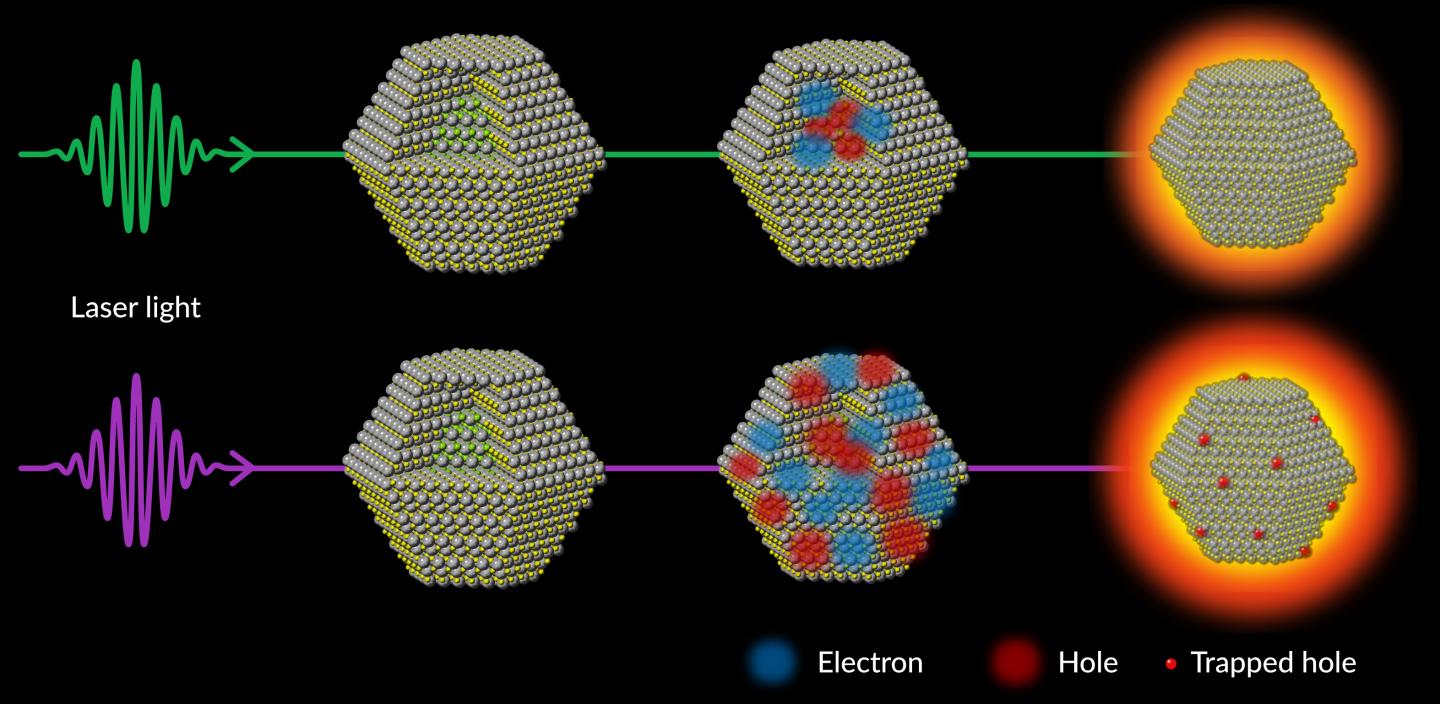What stops quantum dots being brighter?

DOE/SLAC resarchers uncover a process that reduces dots' light-producing efficiency
Attempts to increase the intensity of that light generated by quantum dots tends to generate heat instead, reducing the dots' light-producing efficiency.
A new study by scientists at the US Department of Energy's SLAC National Accelerator Laboratory explains why, and the results have broad implications for developing future quantum and photonics technologies where light replaces electrons in computers and fluids in refrigerators, for example.
The scientists used a high-speed electron camera to watch dots turn incoming high-energy laser light into their own glowing light emissions.
The experiments revealed that the incoming high-energy laser light ejects electrons from the dot's atoms, and their corresponding holes become trapped at the surface of the dot, producing unwanted waste heat.
In addition, electrons and holes recombine in a way that gives off additional heat energy. This increases the jiggling of the dot's atoms, deforms its crystal structure and wastes even more energy that could have gone into making the dots brighter.
"This represents a key way that energy is sucked out of the system without giving rise to light," said Aaron Lindenberg, a Stanford University associate professor and investigator with the Stanford Institute for Materials and Energy Sciences at SLAC who led the study with postdoctoral researcher Burak Guzelturk.
"Trying to figure out what underlies this process has been the subject of study for decades," he said. "This is the first time we could see what the atoms are actually doing while excited state energy is being lost as heat."
The research team, which included scientists from SLAC, Stanford, the University of California, Berkeley and DOE's Lawrence Berkeley National Laboratory, described the results in Nature Communications.
The picture above shows how dots were excited with green light (top) or higher-energy purple light (bottom). When hit with green light, the dots relaxed, and excited pairs of electrons and holes converted virtually all of the incoming energy to light. But when hit with purple light, some of the energy was trapped on the surface of the dot; this distorted the arrangement of surrounding atoms and wasted energy as heat.
Emitting a pure, brilliant glow
Previous studies have focused on how quantum dots' electrons behaved. But in this study, the team was able to see the movements of whole atoms, too, with an electron camera known as MeV-UED. It hits samples with short pulses of electrons with very high energies, measured in millions of electronvolts (MeV). In a process called ultrafast electron diffraction (UED), the electrons scatter off the sample and into detectors, creating patterns that reveal what both electrons and atoms are doing.
As the SLAC/Stanford team measured the behaviour of quantum dots that had been hit with various wavelengths and intensities of laser light, UC Berkeley graduate students Dipti Jasrasaria and John Philbin worked with Berkeley theoretical chemist Eran Rabani to calculate and understand the resulting interplay of electronic and atomic motions from a theoretical standpoint.
A future of light-based technology
The study was carried out by researchers in a DOE Energy Frontier Research Center, Photonics at Thermodynamic Limits, led by Jennifer Dionne, a Stanford associate professor of materials science and engineering and senior associate vice provost of research platforms/shared facilities. Her research group worked with Lindenberg's group to help develop the experimental technique for probing the nanocrystals.
The centre's ultimate goal, Dionne said, is to demonstrate photonic processes, such as light absorption and emission, at the limits of what thermodynamics allows. This could bring about technologies like refrigeration, heating, cooling and energy storage - as well as quantum computers and new engines for space exploration - powered entirely by light.
"To create photonic thermodynamic cycles, you need to precisely control how light, heat, atoms, and electrons interact in materials," Dionne said. "This work is exciting because it provides an unprecedented lens on the electronic and thermal processes that limit the light emission efficiency. The particles studied already have record quantum yields, but now there is a path toward designing almost-perfect optical materials." Such high light emission efficiencies could open a host of big futuristic applications, all driven by tiny dots probed with ultrafast electrons.
'Dynamic lattice distortions driven by surface trapping in semiconductor nanocrystals' by Burak Guzelturk et al; Nature Communications volume 12, Article number: 1860 (2021)


































